A Smart Green Building: An Environmental Health Control Design
Abstract
:1. Motivation and Goal
2. Literature Review
2.1. Environmental Health Age Issues
2.2. Optimized Control Theory and Selected Conditions
| Goal | Organization, literature, year | Themes discussed | Theory and methods | Specific solution | Trend research |
|---|---|---|---|---|---|
| Cities of health | Vancouver Declaration On Human Settlements [5]. | (1) Insufficient quantity of dwellings; (2) Poor residential quality; (3) Coexistence of new and old building types. | Health encompasses physical, mental, environmental, and social aspects. | The cities of health concept emphasizes that the living environment must possess functionality, comfort, and safety planning. | The cities of health concept emphasizes that health is inseparably linked to the living environment. |
| Healthy communities | Declaration of Alma-Ata [6]. | (1) Reflection on the large-scale development of energy; (2) Avoidance of ecological destruction; (3) Reduction in use of synthetic chemical substances. | Communities should implement primary-level health care in order to achieve the goal of health for all. | Healthy communities rely on public participation strategies to achieve sustainable environmental health. | Healthy communities perform the important tasks of promoting health and disease prevention for all, and maintaining public health. |
| Health promotion | Ottawa Charter for Health Promotion [7]. | (1) Increasing consciousness of housing quality; (2) Increasing competitive pressure in society; (3) Wastage of environmental resources. | Health promotion is the process of encouraging people to strengthen control and promotion of physical health. | Health promotion seeks to create healthy supportive environments via public health policy, interdepartmental cooperation, and community participation. | Environments supporting health include: (1) the physical environment; (2) the social environment, and also encompass other relevant environmental developmental technologies. |
| A healthy indoor environment | Study on the Comprehensive Indicators of Indoor Environment Assessment for Occupants’ Health in Taiwan [8]. | Immediate or potential effects of an unhealthy indoor environment on the human body. | To maintain sustainability of the living environment, proposal of health assessment systems and indicators in view of residents’ basic health needs. | Drafting of indoor environmental health and control assessment indicators. | Indoor physical environmental quality factors must possess (1) objectivity; (2) scientific basis; (3) measurability; and (4) comparability. |
| Healthy housing | Technical Essentials for Healthy Housing Construction [9]. | (1) Insufficient social welfare as demographic aging approaches; (2) Problems such as soil and water quality, severe air pollution, and the greenhouse effect. | The healthy housing concept reflects the relationship between health factors and three aspects: basic elements; (2) the living environment, and (3) sustainable development. | Three major systems involved in the establishment of healthy housing: (1) assessment system; (2) technical system, and (3) architectural system. | Proposal of a housing improvement strategy based on architectural quality standards for the purpose of enhancing residential quality, health factors, and health preservation. |
| Smart environments | Insights of Smart Environments [10]. | “Smart environments” are places designed to be user-friendly, employing intelligent solutions (including smart materials and information & communications technology), and which are able to interact with the environment. | The basic principles of a smart environment include: (1) a human-centered design; (2) context-awareness; (3) a high touch architectural plan, and (4) interdisciplinary integration. | (1) Establishment of a responsive building that can meet changing needs, and (2) linkage of virtual space with the real environment. | While fusing information/communications with living applications, a smart environment achieves optimal linkage between design and technology, and takes key issues such as environmental health and sustainability into consideration. |
| Green and intelligent buildings | How do smart buildings make building green? [11]. | (1) Smart green buildings embody sustainable management of environmental health and environmental protection/energy conservation/carbon emissions reduction features; (2) Smart green buildings emphasize quality of life, individualization, and customization. | Smart green buildings incorporate sustainable environmental protection and smart technologies within the building, creating an architectural space capable of active sensing and meeting users’ needs. | Based on a green building, a smart green building incorporates smart high-tech technologies, materials, and product applications, making the building safer, healthier, more convenient, and more comfortable, while conserving energy and reducing carbon emissions. | Combination of information design, electromechanical design, industrial design, and architectural design in response to the need for (1) safety; (2) health; (3) comfort; (4) energy conservation, while creating a human-centered living space. |
3. Optimized Control of Environmental Health


4. Use of the S House as an Example
4.1. Overview of Site Conditions and Design Concept
| Dimension | Smart green building technological applications [13] | Living objectives | |||
|---|---|---|---|---|---|
| Safety & peace of mind | Health maintenance | Convenience & comfort | Sustainability & energy conservation | ||
| Architectural plan | Analysis of regional climate and seasonality | * | |||
| Mountain slope water and soil conservation | * | * | |||
| Disaster prediction and control | * | ||||
| Regional ecological survey and impact assessment | * | * | |||
| Demographic change analysis | |||||
| Open architecture | * | * | |||
| Modular design | * | * | |||
| Fair-faced concrete pre-cast construction | * | * | |||
| Adaptive spatial design for lifelong house | * | * | * | ||
| General purpose architecture and interior planning | * | * | * | ||
| Dry compartment wall construction | * | * | * | ||
| Flat slab construction | * | * | * | ||
| Lofted lower floor ceiling and anti-pest design | * | * | * | ||
| Security and alarm system | * | ||||
| Environmental health control | Air quality survey | * | * | * | |
| Noise control | * | ||||
| Water quality survey | * | * | * | ||
| Microclimate monitoring system (weather station) | * | * | * | * | |
| Healthy air quality monitoring system | * | * | * | * | |
| Thermal buoyancy ventilation staircase and automatic control Ventilation tower | * | * | * | * | |
| Solar water heater | * | * | * | * | |
| Natural ventilation plan | * | * | * | * | |
| Natural insulation, sun protection, natural lighting facade design | * | * | * | * | |
| Indoor situational control system | * | * | |||
| Landscaping | Optimized visual landscaping façade | * | * | * | * |
| Rainwater recycling, gray water irrigation system | * | * | * | * | |
| Vegetation suitable for the local climate | * | * | * | * | |
| Atrium landscaping bridge reducing ecological impact and balcony design | * | * | * | * | |
| Seismic isolation system | Main structure seismic isolation system | * | * | * | * |
| Isolator | * | * | * | * | |
| Hollow floor slabs | * | * | * | ||
| Earthquakes sensor | * | * | * | ||
| Sustainability | Property management system | * | * | * | |
| Hotel-style management team | |||||
| Building life cycle management | * | * | * | * | |
4.2. Compliance with Passive Design Principles

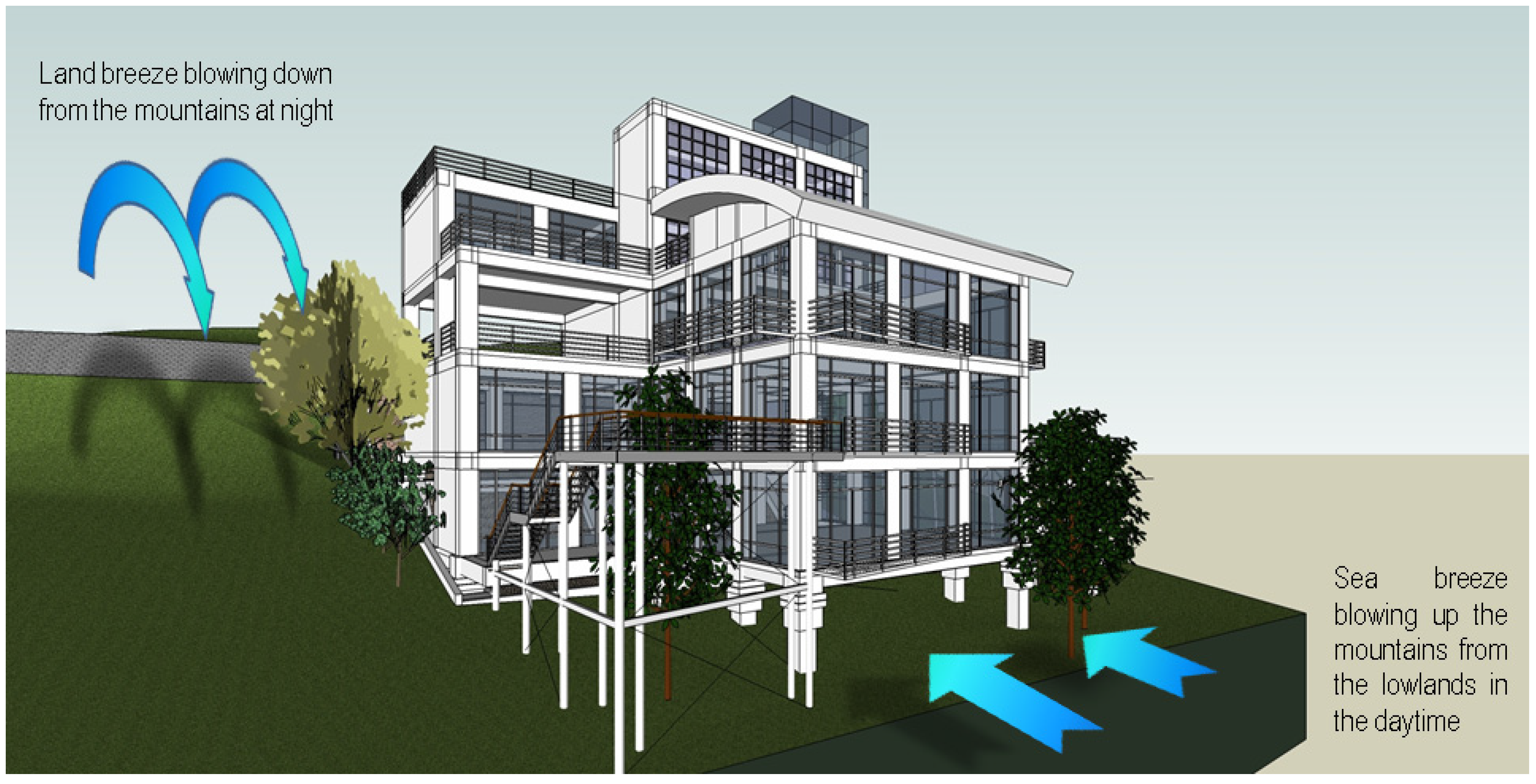
4.3. Selection of Intelligent Conditions
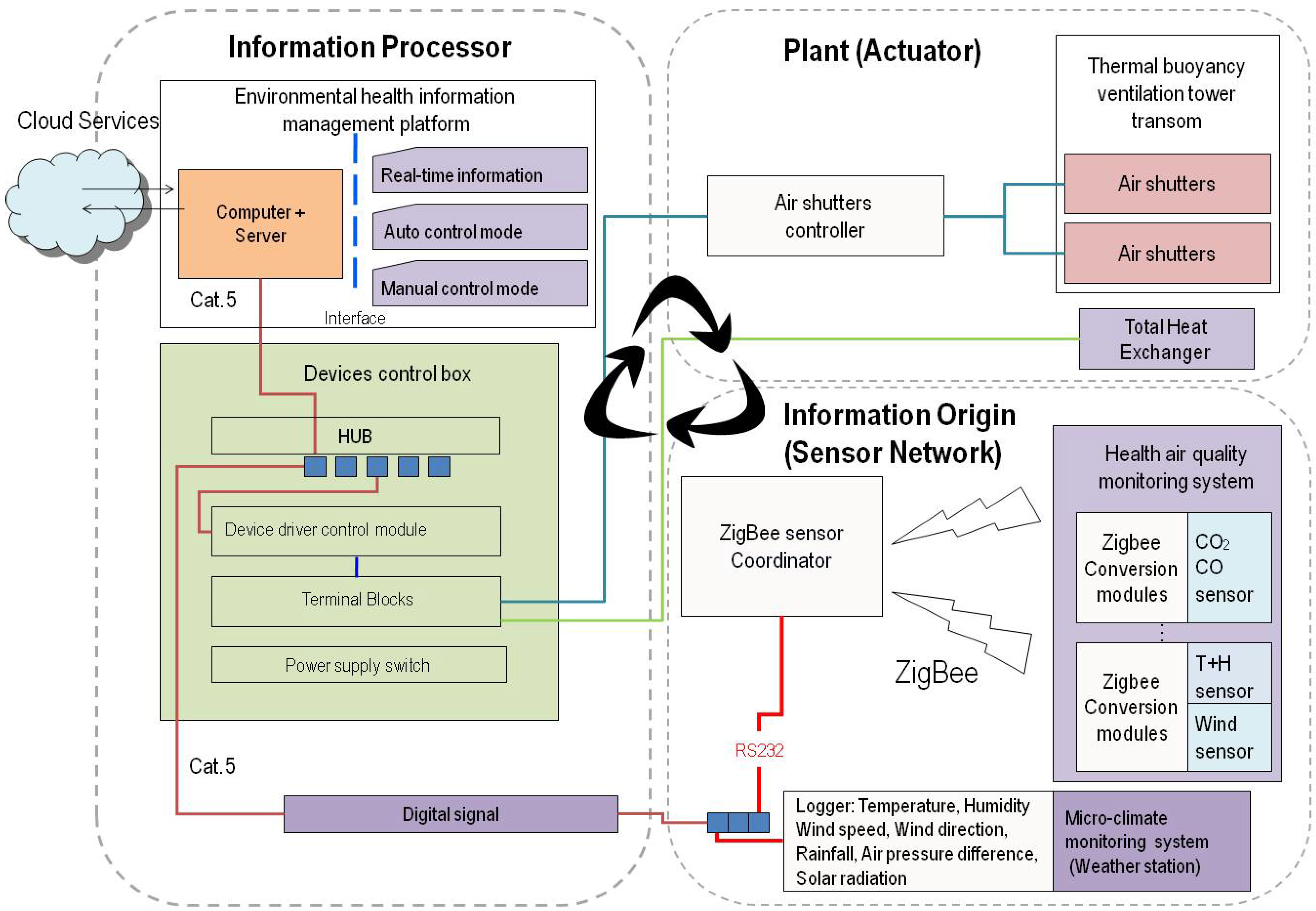
4.4. Optimized Control
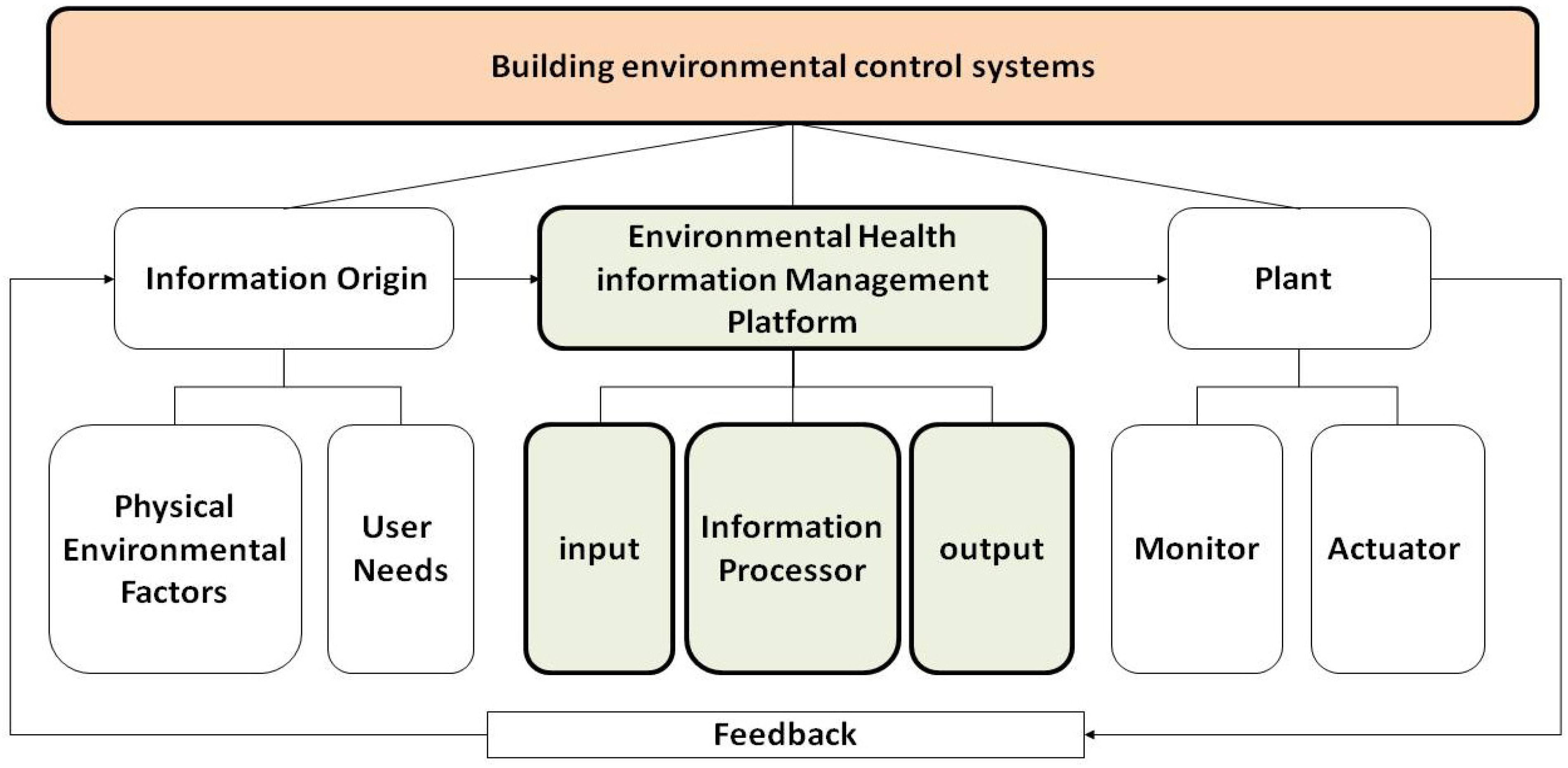
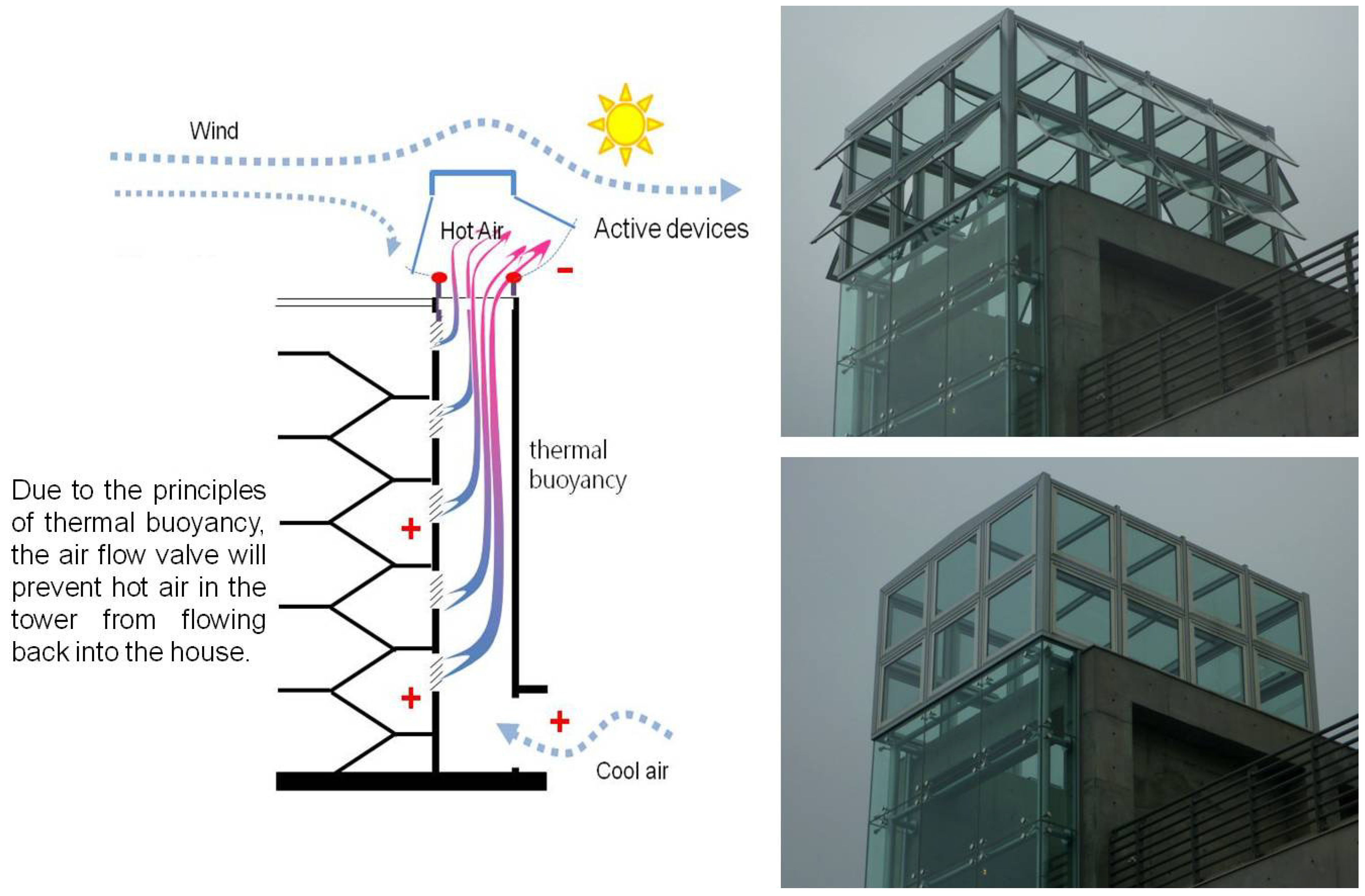
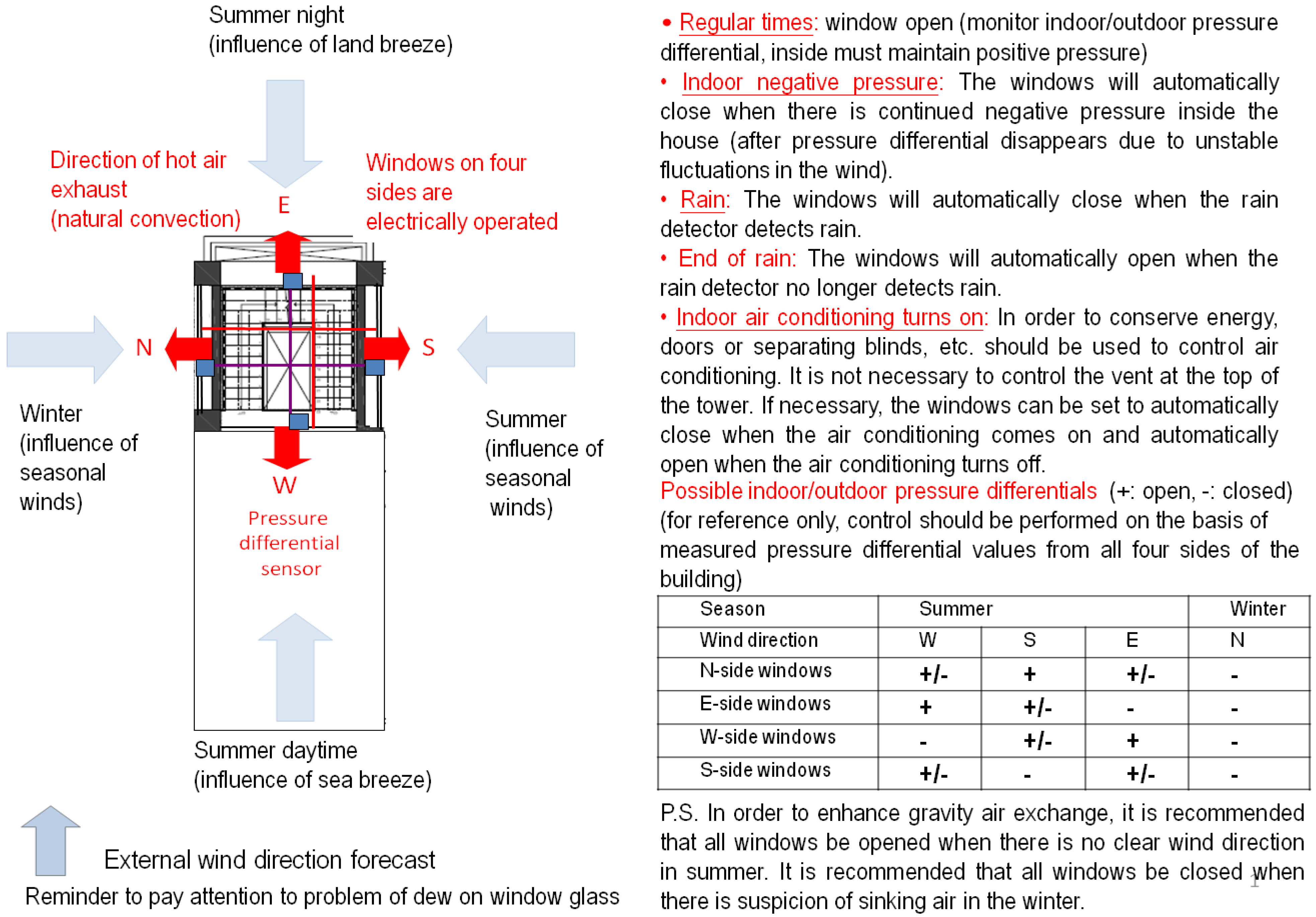
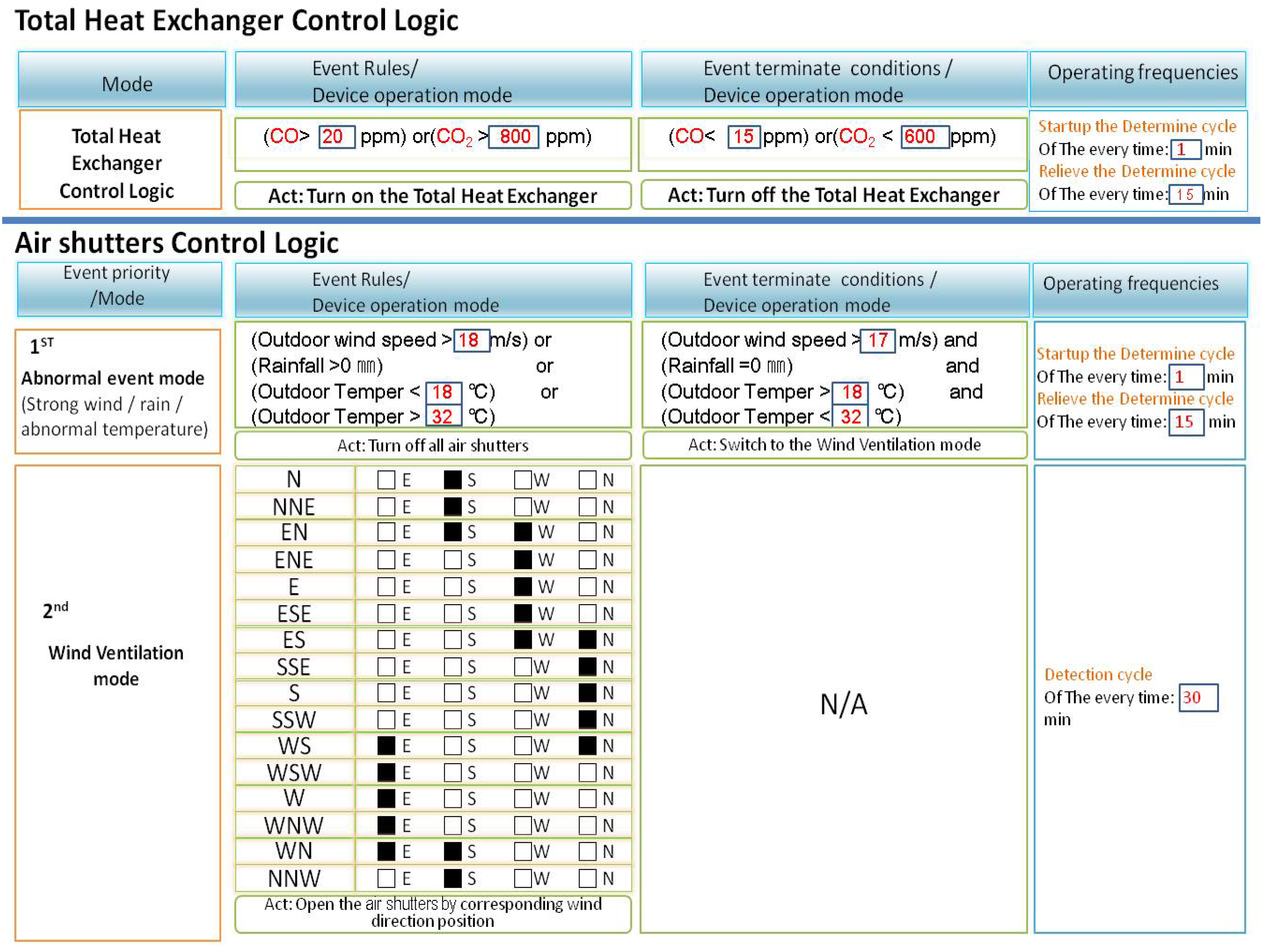
4.5. The Environmental Health Information Management Platform Interface
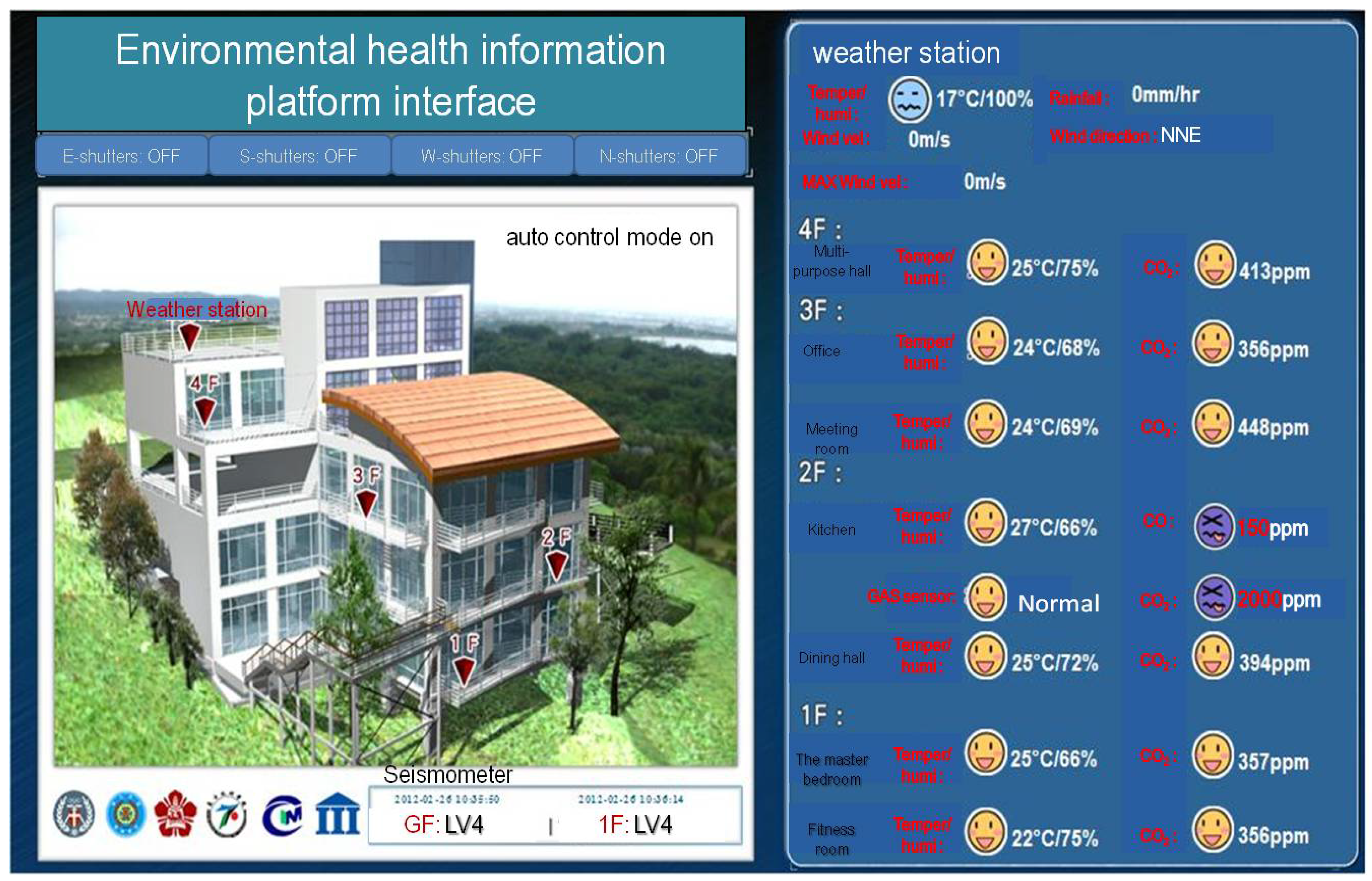
5. Recommendations and Discussion
- (1)
- Pursuit of maximum health quality and minimum equipment energy consumption: Home users always seek a healthy and comfortable residential environment. When considering sustainability, including energy conservation and carbon emissions reduction, a passive design should receive first consideration. However, smart situation control can be used to drive adaptive architectural elements and thereby make up for the deficiencies of the passive design. Furthermore, only when a passive design is inadequate to maintain environmental health, such as during the occurrence of special conditions, will the system use active equipment (such as air conditioning and total heat exchangers) to maintain a comfortable environment.
- (2)
- Sensor installation and active actuation device installation conditions: inappropriately or insufficiently intelligent facilities and equipment may disturb residential users’ normal lives. For instance, when all windows are actively actuated, the noise from the window operation is frequently a cause of complaints by the users. Nevertheless, the use of necessary equipment can improve health conditions and prevent hazards. For instance, because people are generally unable to detect high concentrations of harmful pollutants such as CO and CO2, the installation of CO sensors in kitchens and CO2 sensors on the ceilings of rooms often containing many persons, such as living rooms, is clearly very appropriate. In addition, the installation of actively actuated air shutters in staircases, which seldom attract much attention or contain people for very long, and especially in relatively inaccessible ventilation towers, is obviously very thoughtful.
- (3)
- Restrictions on logic control: In keeping with the sporadic, dynamic, discrete, and nonlinear nature of changes in the physical environment and user needs, this study recommends the adoption of logic control in an optimized control actuation model. Nevertheless, although commonly-used binary rule-type control methods employing specific threshold values are indeed simple, they easily give rise to conflicts. For instance, although the literature states that people will feel discomfort when the CO2 concentration is greater than 800 ppm, the personnel participating in design of the S House felt very comfortable on an occasion when the CO2 concentration of a full conference room exceeded 1,200 ppm. Because the human body’s feeling of comfort is a subset consisting of values within a certain scope and contrasting with other factors, if-then logical conditions should be multi-value versus multi-element. The widely-used binary rule control approach uses specific threshold values, and is extremely simple. Its only limitation is the use of priority to resolve conflicts, and it can only be used for the actuation of equipment with open and shut actions.
Acknowledgments
References
- World Health Organization (WHO) Home Page: Frequently asked questions No. 4—What is WHO’s definition of health? Available online: http://www.who.int/kobe_centre/about/faq/en/ (accessed on 14 May 2012).
- Bryson, A.E.; Ho, Y.-C., Jr. Applied Optimal Control: Optimization, Estimation, and Control; John Wiley & Sons: New York, NY, USA, 1975; pp. 25–34. [Google Scholar]
- Chen, T.T. Optimal Control for Applications of Bio-Medical Technology [In Chinese]; National Cheng Kung University Naval Architecture & Marine Engineering Institutional Repository: Tainan City, Taiwan, 2002; pp. 1–7. [Google Scholar]
- Landau, D.L.; Courtiol, B. Adaptive model following systems for flight control and simulation. In Proceedings of AIAA 10th Aerospace Sciences, San Diego, CA, USA; 1972. [Google Scholar]
- The United Nations Human Settlements Programme (UN-HABITAT). The Vancouver Declaration on Human Settlements. In Presented at United Nations Conference on Human Settlements, the First Habitat Conference, Vancouver, Canada, 31 May–11 June, 1976; Available online: http://www.unhabitat.org/downloads/docs/924_21239_The_Vancouver_Declaration.pdf (accessed on 14 May 2012).
- WHO. Declaration of Alma-Ata. In Presented at International Conference on Primary Health Care, Alma-Ata, Kazakhstan, 6–12 September, 1978; Available online: http://www.who.int/hpr/NPH/docs/declaration_almaata.pdf (accessed on 14 May 2012).
- WHO. Ottawa Charter for Health Promotion. In Presented at First International Conference on Health Promotion, Ottawa, Canada, 21 November 1986; WHO/HPR/HEP/95.1. Available online: http://www.who.int/hpr/NPH/docs/ottawa_charter_hp.pdf (accessed on 14 May 2012).
- Chiang, C.M.; Lai, C.-M.; Chou, P.-C.; Li, Y.-Y.; Tu, Y.-F. The Study on the Comprehensive Indicators of Indoor Environment Assessment for Occupants’ Health in Taiwan. In Proceedings of ASIA-PACIFIC Conference on the Built Environment, Taipei, Taiwan; 1999; pp. 10:1–10:7. Available online: http://www.pws.stu.edu.tw/paul/B_Conference/B024.pdf (accessed on 14 May 2012). [Google Scholar]
- China National Engineering Research Center for Human Settlements. The technical essentials for healthy housing construction [In Chinese]. 2004. Beijing Time IAP Co., Ltd. Web site.. Available online: http://www.iapchina.com/zhishi/jsbz/jsbz7.pdf (accessed on 14 May 2012).
- Chiu, M.L. Insights of Smart Environments [In Chinese]; Taiwan Architecture: Taipei, Taiwan, 2005; pp. 17–44. [Google Scholar]
- Sinopoli, J. How do Smart Buildings Make a Building Green? Available online: http://www.caba.org/resources/Documents/iHomes_Spring08_web.pdf (accessed on 14 May 2012).
- Campion, M.A.; Lord, R.G. A control systems conceptualization of the goal-setting and changing process. Organ. Behav. Hum. Perf. 1982, 30, 265–287. [Google Scholar] [CrossRef]
- The Smart Green Building under the Tropic of Cancer in Chiayi, Taiwan. Available online: http://www.youtube.com/watch?v=LaSLuxLkQ4Y (accessed on 21 May 2012).
- Commonwealth of Australia. The Australian Government and the Design and Construction Industries, Your Home Technical Manual; Department of Climate Change and Energy Efficiency: Canberra, Australia, 2010. Available online: http://www.yourhome.gov.au/technical/fs41.html (accessed on 14 May 2012).
- Yeang, K. The Skyscraper Bioclimatically Consideration: A Design Primer; Wiley Academic: New York, NY, USA, 2004; pp. 8, 155 and 204. [Google Scholar]
- Environmental Health Information Platform Interface [In Chinese]. Available online: http://59.120.104.100/web/ (accessed on 21 May 2012).
© 2012 by the authors; licensee MDPI, Basel, Switzerland. This article is an open access article distributed under the terms and conditions of the Creative Commons Attribution license (http://creativecommons.org/licenses/by/3.0/).
Share and Cite
Chen, S.-Y.; Huang, J.-T. A Smart Green Building: An Environmental Health Control Design. Energies 2012, 5, 1648-1663. https://doi.org/10.3390/en5051648
Chen S-Y, Huang J-T. A Smart Green Building: An Environmental Health Control Design. Energies. 2012; 5(5):1648-1663. https://doi.org/10.3390/en5051648
Chicago/Turabian StyleChen, Shang-Yuan, and Jui-Ting Huang. 2012. "A Smart Green Building: An Environmental Health Control Design" Energies 5, no. 5: 1648-1663. https://doi.org/10.3390/en5051648




